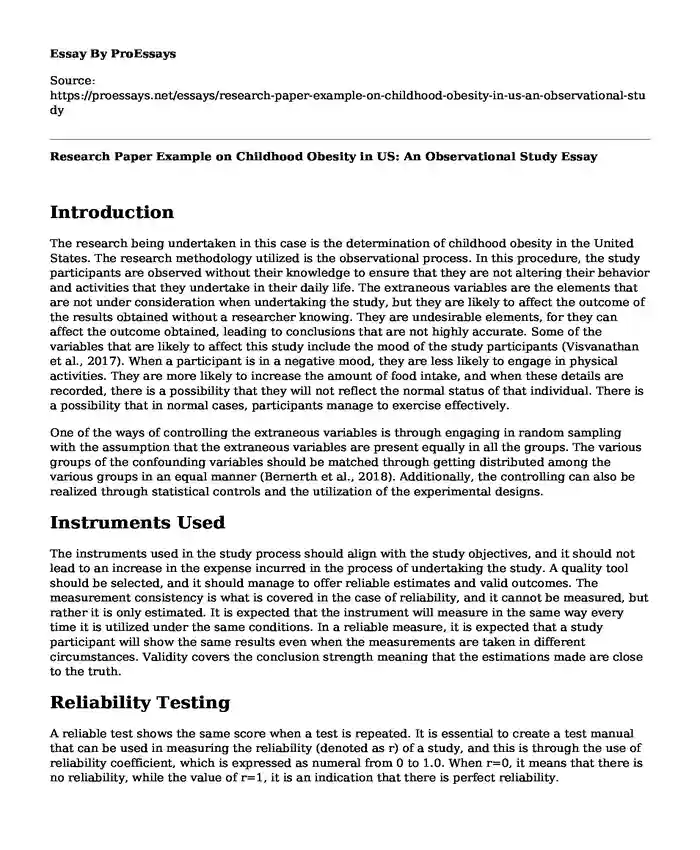Introduction
The research being undertaken in this case is the determination of childhood obesity in the United States. The research methodology utilized is the observational process. In this procedure, the study participants are observed without their knowledge to ensure that they are not altering their behavior and activities that they undertake in their daily life. The extraneous variables are the elements that are not under consideration when undertaking the study, but they are likely to affect the outcome of the results obtained without a researcher knowing. They are undesirable elements, for they can affect the outcome obtained, leading to conclusions that are not highly accurate. Some of the variables that are likely to affect this study include the mood of the study participants (Visvanathan et al., 2017). When a participant is in a negative mood, they are less likely to engage in physical activities. They are more likely to increase the amount of food intake, and when these details are recorded, there is a possibility that they will not reflect the normal status of that individual. There is a possibility that in normal cases, participants manage to exercise effectively.
One of the ways of controlling the extraneous variables is through engaging in random sampling with the assumption that the extraneous variables are present equally in all the groups. The various groups of the confounding variables should be matched through getting distributed among the various groups in an equal manner (Bernerth et al., 2018). Additionally, the controlling can also be realized through statistical controls and the utilization of the experimental designs.
Instruments Used
The instruments used in the study process should align with the study objectives, and it should not lead to an increase in the expense incurred in the process of undertaking the study. A quality tool should be selected, and it should manage to offer reliable estimates and valid outcomes. The measurement consistency is what is covered in the case of reliability, and it cannot be measured, but rather it is only estimated. It is expected that the instrument will measure in the same way every time it is utilized under the same conditions. In a reliable measure, it is expected that a study participant will show the same results even when the measurements are taken in different circumstances. Validity covers the conclusion strength meaning that the estimations made are close to the truth.
Reliability Testing
A reliable test shows the same score when a test is repeated. It is essential to create a test manual that can be used in measuring the reliability (denoted as r) of a study, and this is through the use of reliability coefficient, which is expressed as numeral from 0 to 1.0. When r=0, it means that there is no reliability, while the value of r=1, it is an indication that there is perfect reliability.
Validity Test Manual
The intervention measures that can be undertaken to ensure that an instrument is reliable and is offering valid outcomes is to use the statistical method of research and the random sampling process. The confounding variable should be matched to ensure that they are equally distributed amongst the various created groups. The data collection process that will be used in this research will be the observational process, and the noted details will be recorded (Peach et al., 2018). Additionally, the literature review procedure will prove critical for it will help to realize the details obtained by other researchers in the same field.
Conclusion
The steps that will be followed in the data collection process will be identify the data collection opportunities, which in this case is childhood obesity among children in the United States. The next step is to select the issue and set goals, plan the approach, the data is collected, analyzed, and the results are published.
References
Bernerth, J. B., Cole, M. S., Taylor, E. C., & Walker, H. J. (2018). Control variables in leadership research: A qualitative and quantitative review. Journal of Management, 44(1), 131-160.
https://doi.org/10.1177/0149206317690586
Peach, R. K., Schenk, K. A., Nathan, M. R., & Beck, K. M. (2018). Construct validity, external validity, and reliability for a battery of language-specific attention tasks. Aphasiology, 32(6), 618-645. https://doi.org/10.1080/02687038.2018.1454885
Visvanathan, K., Levit, L. A., Raghavan, D., Hudis, C. A., Wong, S., Dueck, A., & Lyman, G. H. (2017). Untapped potential of observational research to inform clinical decision making: American Society of Clinical Oncology research statement. Journal of Clinical Oncology, 35(16), 1845-1854.
https://ascopubs.org/doi/full/10.1200/JCO.2017.72.6414
Cite this page
Research Paper Example on Childhood Obesity in US: An Observational Study. (2023, Oct 15). Retrieved from https://proessays.net/essays/research-paper-example-on-childhood-obesity-in-us-an-observational-study
If you are the original author of this essay and no longer wish to have it published on the ProEssays website, please click below to request its removal:
- Contemporary Public Opinion: Issues and the News
- Essay Example on Youth Gangs in Canada: A Sociological Study on Causes and Risks
- Essay Example on Women's History: Social Impact and Victorian Domesticity in the Early 1960s
- Feminist Critical Approaches: Changing the Perception of a Tale - Essay Sample
- Mark Twain's Adventures of Huckleberry Finn: A Journey of Pre-War Racism & Dysfunction - Essay Sample
- Paper Sample on Pop Culture: Definition, Participation & Role in Society
- Essay Example on Police Use of Force: 3 Perspectives on a Complex Issue







